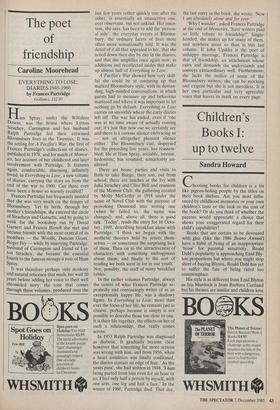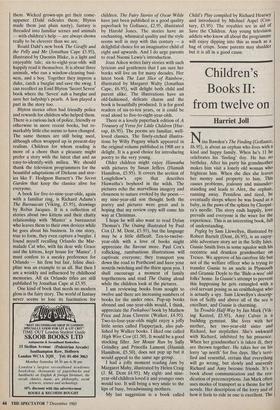Children's Books I: up to twelve
Sandra Howard
Choosing books for children is a bit like pigeon-holing people by the titles on their book shelves. Are you most influ- enced by childhood memories or your own children's taste or the look or the cost of the book? Or do you think of whether the parents would appreciate a choice that shows your exaggerated regard for their child's capabilities?
Books that are certain to be devoured with glee (like the 1986 Beano Annual) have a habit of being of an inappropriate 'brow' for parental sensitivity. Roald Dahl's popularity is approaching Enid Bly- ton proportions but where you might stop short of buying Blyton, Roald Dahl has yet to suffer the fate of being rated too commonplace.
His style is as different from Enid Blyton as Iris Murdoch is from Barbara Cartland but his themes are similar and children love them. Wicked grown-ups get their come- uppance (Dahl ridicules them; Blyton made them just plain nasty), fantasy is threaded into familiar scenes and animals — with children's help — are always shown really to be cleverer than we are.
Roald Dahl's new book The Giraffe and the Pelly and Me (Jonathan Cape £5.95), illustrated by Quentin Blake, is a light and enjoyable tale; six-to-eight-year-olds will happily read it themselves. It is about three animals, who run a window-cleaning busi- ness, and a boy. Together they impress a duke, catch a burglar and save the swag. I can recollect an Enid Blyton 'Secret Seven' book where the 'Seven' nab a burglar and save her ladyship's pearls. A lion played a part in the story too.
Blyton stories often had friendly police and rewards for children who helped them. There is a curious lack of police, friendly or otherwise in more recent books, but re- markably little else seems to have changed. The same themes are still being used, although often wrapped up in present-day realism. Children for whom reading is more of a chore than a pleasure might prefer a story with the latest chat and an easy-to-identify-with milieu. We should thank the television programmers for the beautiful adaptations of Dickens and stor- ies like F. Hodgson Burnett's The Secret Garden that keep the classics alive for everyone_ A book for five-to-nine-year-olds, again with a familiar ring, is Richard Adams's The Bureaucats (Viking, £5.95), drawings by Robin Jacques. It is a collection of stories about two kittens and their chatty relationship with 'Master' a bureaucrat who leaves them to their own devices while he goes about his business. In one story, true to form, they even capture a burglar. I found myself recalling Orlando the Mar- malade Cat who, with his dear wife Grace and the kittens, kept house for 'Master'. I must confess to a sneaky preference for Orlando — his firm but fair, feline disci- pline was an example to us all. But then I am a wrinkly and influenced by childhood memories. All six Orlando titles are still published by Jonathan Cape at £5.95.
One kind of book that needs no modern gloss is the fairy story. The world of fantasy never seems to lose its fascination for children. The Fairy Stories of Oscar Wilde have just been published in a good quality paperback by Gollancz, £2.95, illustrated by Harold Jones. The stories have an enchanting, whimsical quality and the style seems well in step with this century — a delightful choice for an imaginative child of eight and upwards. And I do urge parents to read Naomi Lewis's introduction.
Joan Aiken writes fairy stories with such lyricism and gentleness that I am sure her books will live on for many decades. Her latest book The Last Slice of Rainbow, illustrated by Margaret Walty (Jonathan Cape, £6.95), will delight both child and parent alike. The illustrations have an old-fashioned, delicate charm and the book is beautifully produced. It is for good readers of six-to-ten years, or it could be read aloud to five-to-eight-year-olds.
There is a lovely paperback edition of A Treasury of Verse for Little Children (Har- rap, £6.95). The poems are familiar, well- loved classics. The finely-etched illustra- tions by Willy Pogany which appeared in the original volume published in 1908 are a delight. It is a good choice for introducing poetry to the very young.
Older children might enjoy Hiawatha with pictures by Susan Jeffers (Hamish Hamilton, £5.95). It covers the section of Longfellow's epic that describes Hiawatha's boyhood in the wilds. The pictures echo the marvellous imagery and closeness to nature evoked by the poem my nine-year-old son thought both the poetry and pictures were great and is hoping that my review copy will come his way at Christmas.
I hope he will also want to read Dylan Thomas's The Outing illustrated by Paul Cox (J. M. Dent, £5.95), but the language may be a little difficult. Ten-to-twelve- year-olds with a love of books might appreciate the flavour more. Paul Cox's rollicking, rumbustious illustrations will captivate everyone; they transport you down the road to Porthcawl and have your nostrils twitching and the thirst upon you. I shall encourage a moment of family togetherness and read The Outing aloud while the children look at the pictures.
I am reviewing books from nought to twelve and there are increasing numbers of books for the under ones. Pop-up books abound and one-year-olds would, I think, appreciate the Peekaboo! book by Mathew Price and Jean Claverie (Walker, £4.95). Two-to-four-year-olds might enjoy a jolly little series called Flapperjack, also pub- lished by Walker books. I liked one called High Wire Cow (£1.50). It would be a good stocking filler. See Mouse Run by Sally Grindley and Priscella Lamont (Hamish Hamilton, £5.50), does not pop up but it would appeal to the same age group.
I had a jolly moment reading Jam by Margaret Mahy, illustrated by Helen Craig (J. M. Dent £4.95). My eight- and nine- year-old children loved it and younger ones would too. It will bring a wry smile to the lips of busy, breadwinning mothers.
My last suggestion is a book called Child's Play compiled by Richard Hearsay and introduced by Michael Aspel (Cen- tury, £5.95). The royalties are in aid of Save the Children. Any young television addicts who know all about the programme will enjoy dipping into this as much as a bag of crisps. Some parents may shudder but it is all in a good cause.



































































 Previous page
Previous page